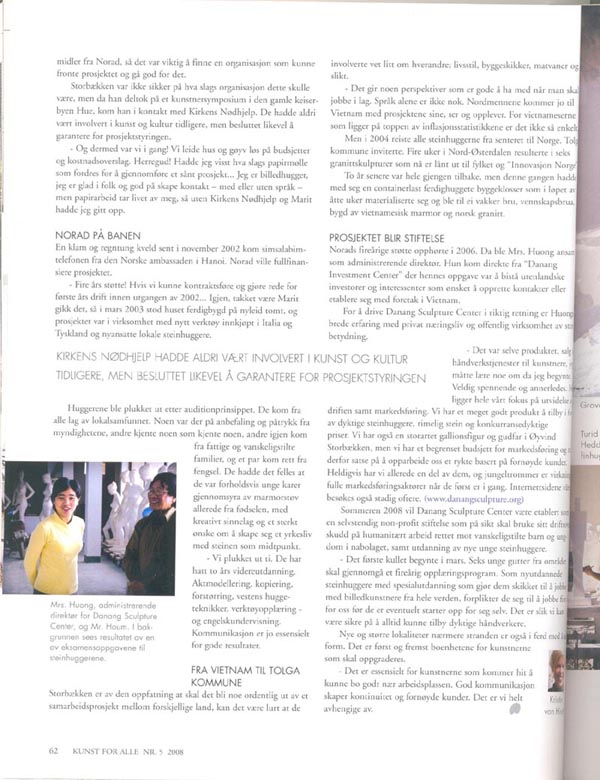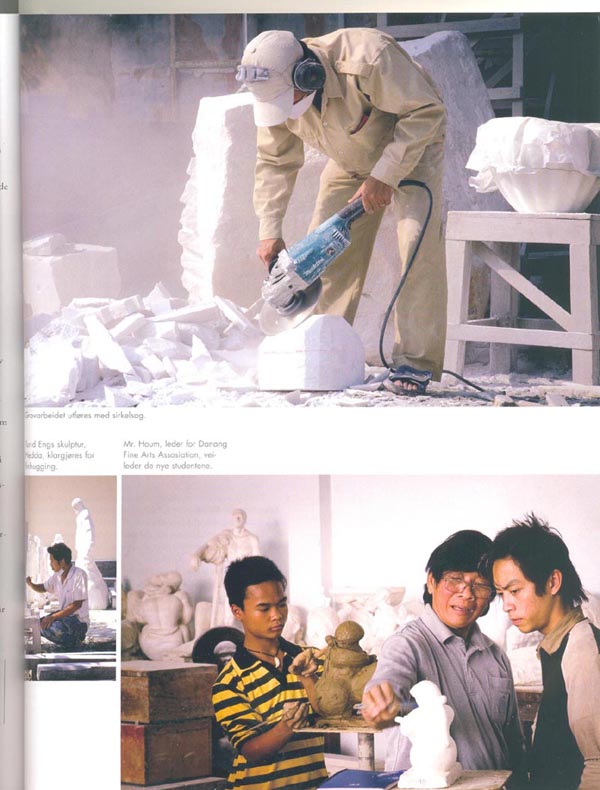Danang Sculpture Center - A place in Viet Nam where Stone carvers give qualified support.
“Kunst for alle” (“Art for everybody”) No. 5-08
Behind the tall entrance gate lies piles of stones. Tons and tons of marble. White, yellow, light grey and pink, and the odd granite colossus. I can get you everything. Just tell me what you need.
Stone sculptor Oyvind Storbaekken smiles in his beard and shows us around. We are in Danang Sculpture Center, a place in the world where artists from Norway can buy stone and qualified assistance to implement their sculpture projects without production costs exceeding their remuneration. It is located in the Non Nuoc village (today on the outskirts of Danang), center for stone carving traditions in Viet Nam.
It all begun at the beginning of the new Millennium
Stone sculptor Oyvind Storbaekken traveled to Viet Nam together with Dang Van Ty, a Vietnamese wheelchair artist. They knew each other from the Academy (Oslo National Academy of the Arts) and the occasion was the Vietnamese painter’s debut exhibition in Hanoi.
Storbaekken had always wanted to go to Viet Nam, but as he says:
- To go somewhere without having anything to do there, is not something I am good at. Therefore, this was a welcome opportunity to experience an exciting country closely.
It went above all expectations. The reception was enormous, first and foremost for the artist, but also for his accompanies, and Storbaekken, who at this point of time preferred wood as his material, was also asked to exhibit in Hanoi. He would really like that, but the problem was the freight of the sculptures. It was too expensive.
- I was then immediately offered six months of board and lodging with a wood carver in Hanoi’s wood carver street, with a promise of an exhibition of my production in this period. The Communist Party of Viet Nam was the host for the arrangement. Then all I had to do was to pack my suitcase.
From wood to stone
Three months later he sat on the street working with Hanoi’s wood carvers.
- The roads were extremely steep and the trucks in a bad condition. We went all black by exhaust and soot, and the level of noise was insane, but I managed to produce quite a bit, and the result was a separate exhibition in Hanoi in 2002. The interest was so big that a TV documentary was produced, and Storbaekken’s face was all over the newspapers’ front pages.
- In spite of limited resources and visible poverty, the Vietnamese showed so much goodwill and hospitality in this period that I decided to do something in return. People were eager to have contact with the outside world which I was a part of so it was natural to think about exchange and cooperation.
But since wood from the rain forest was and is such a sensitive issue for most people, I decided it would have to be stone. To cut marble and other stone is expensive in Norway, and Carrara in Italy, all stone carvers’ Mecca through many years, was also about to out-price itself. Therefore, it was time to find a new and equally good place for the production of large sculptures. Storbaekken travelled southwards to Danang, to visit Viet Nam’s stone carving environment. The basis of existence, five holy marble and limestone mountains peaking up from the flat coastal plains, had through the times given enough marble to the production of enormous amounts of Buddhas, Shivas, lions, dolphins, dragons, tigers and Ho Chi Minhs ‘and a few Jesus’. Now these mountains are protected area, but as the stone carvers and their families live and always have lived at the foot of these mountains, this is still the area for stone carving even though the stone is now transported from other parts of the country.
- In Danang I met Mr. Hong, head of Danang Fine Arts Association, and Mr. Hoang, a restaurant owner with a positive attitude and a large network. Both thought the idea of educating some of the stone carvers to make them better equipped to handle requests from Western artists was interesting. East and West have a very different approach concerning both shape and anatomy.
Goodwill from all sides
Storbaekken made a proposal to the Norwegian Ministry of Foreign Affairs about funding for a pilot project, and were granted NOK 150 000 (US$ 21 500).
- Marit, my wife, and I had decided to go anyhow, but the funding was welcome and showed us more than anything that our thoughts were not completely unrealistic. So I put up a shed in Danang and made a three meter tall marble sculpture, the Ice Queen, while I did some research and established a contact network. Together with People’s Committee and Danang Fine Arts Association we made a proposal for a four year project to establish a center. The Norwegian Embassy told us that private persons never receive grants from Norad (The Norwegian Agency for Development Cooperation), so it was crucial to find an organisation that could promote and support our project.
Storbaekken was not sure what kind of organisation this should be, but when he participated in an artist symposium in the old emperors’ capital Hue, he got in contact with Norwegian Church Aid. They had never been involved in arts and culture projects earlier, but in spite of this they agreed to guarantee for the project management.
- And then we got started! We rented a house and got going with budgets and costs estimates. If I had known the required paper work to implement a project like this… I am a stone carver, I love people and I am good at establishing contacts ‘with or without language’ but paper work kills me. Without Norwegian Church Aid and Marit I would have given up.
Norad interested
A sticky and rainy evening in late November 2002 came the magic phone call from the Norwegian Embassy in Hanoi. Norad wanted to fund the project in total.
- Four years of funding! If we could make contracts and accounts for the running of the first year by the end of 2002… Again, thanks to Marit, we made it, so in March 2003 the house was built on a newly rented plot, and the project was running with new equipment bought in Italy and Germany and newly employed local stone carvers.
The stone carvers were selected following the audition principle. They came from all layers of the local community. Some were there based on recommendations from the authorities, some knew someone who knew someone, others came from poor and disadvantaged families and a couple came straight from jail. Their common characteristics were that they were relatively young men ‘permeated’ by marble dust from the day they were born, they had creative minds and a strong wish to make a working life with the stone as a centre.
- We selected ten people. They have had two years of further education, nude modelling, copying, enlarging, Western cutting techniques, tool training, and English. Communication is essential for good results.
From Viet Nam to Tolga Commune
Storbaekken thinks that in order to achieve a good result in a cooperation project between two countries, it can be useful that the people involved know a little about each others life style, building customs, eating habits etc.
- It gives some useful perspectives when you are working together. Language alone is not enough. The Norwegians come to Viet Nam with their projects, they see and they experience things. For Vietnamese who live with a high inflation rate it is not so easy.
But in 2004 all the stone carvers from the Center travelled to Norway. Tolga Commune invited them. Four weeks in Nord-Oesterdalen resulted in six granite sculptures which now are lent out to the Hedmark County and to Innovation Norway.
Two years later the whole lot was back, but this time they brought with them a container with ready made building blocks which during the next eight weeks materialised into a beautiful bridge, the friendship bridge, built by Vietnamese marble and Norwegian granite.
The projects becomes a foundation
Norads’ four year funding ended in 2006. Then Mrs. Huong was employed as managing director. She came from the Danang Investment Center, where her responsibility was to support foreign investors and interested parties who wished to establish contacts or business in Viet Nam.
To run Danang Sculpture Center in the right direction, Huong’s broad experience with both private and public enterprise is of great significance.
- It was the product itself, sale of craftsmen services to artists, issues I had to learn about when I started. Very exciting and different. Now our focus is on expansion and marketing. We have a very good product to offer in terms of competent stone carvers, and reasonably and competitively priced stone. We also have a splendid ‘God father’ in Oyvind Storbaekken, while we have a limited budget for marketing and we will therefore work towards having a good reputation based on satisfied customers. Fortunately, we already have quite a few and spreading the word is an effective method of marketing. Our internet pages are also getting more and more visitors (http://www.danangsculpture.org).
The summer of 2008 Danang Sculpture Center will be established as an independent non-profit foundation, which in the longer term will use its’ surplus on humanitarian work for disadvantaged children and youth in the local area, as well as education of new, young stone carvers.
- The first class started in March. Six young boys from the area will undertake a four year training program. As newly qualified stone carvers specially trained in working with artists from all over the world, they commit themselves to work for us for four years before possibly starting their own business. In this way we can always be certain that we can offer competent craftsmen.
New and larger localities closer to the beach is also about to materialise. It is mainly the accommodation facilities for the visiting artists that will be upgraded.
- It is essential for the artists who come here to be able to stay comfortably near the workplace. Good communication creates continuity and satisfied customers. We depend fully upon that.



